2019 KCSE Aviation Technology Paper 1 Past Paper
1. State two safety precautions to be observed with respect to dressing when operating a grinding machine. (1 mark)
(b) Give the classes of fire likely to occur in each of the following areas:
(i) Aircraft technical records
(ii) Paint store (1 mark)
(c) Outline two mandatory safety equipment to be carried by an aircraft flying over water.(1 mark)
2. (a) State four ways of preventing accidents in an aviation environment. (2 marks)
(b) Highlight two roles of a flight dispatcher. (1 mark)
3. (a) Outline three reasons for abnormal moods and poor decision-making in aviation industry. (3 marks)
(b) Outline three adverse effects of cumulonimbus clouds on an aircraft in flight.
4. (a) Sketch and label the following aircraft hardware:
(0 Countersunk rivet
(ii) Raised head screw
(b) Outline the procedure of annealing steel.
5. State the use of each of the following tools:
(a) Odd leg callipers
(b) Flat screw driver
6. (a) Differentiate between propeller driven and pure jet engine methods of thrust generation.(2 marks)
(b) Explain why propeller blades are twisted.(1 mark)
7. (a) Explain the functions of each of the main structural member of the semi-monocoque
aircraft-construction.
(b) Name four methods of non destructive testing used in aircraft inspection. (2 marks)
8. (a) State four methods used in aircraft navigation. (2 marks)
(b) With regards to aircraft systems, complete Table 1.(4 marks)
| Part | System | Function |
|---|---|---|
| Pump | ||
| Transformer | ||
| Thermocouple | ||
| Actuator |
9. With the aid of labelled sketches, show the airflow over each of the following body shapes:
(a) Flat plate(2 marks)
(b) Stationary sphere(2 marks)
(c) Asymmetrical airflow at 0 angle of attack(2 marks)
10. (a) Draw the following types of lines used in engineering drawings:
(i) Centre line
(ii) Hidden detail line (1 marks)
(b) Figure 1 shows two views of an aircraft part drawn in first angle orthographic projection. Draw the plan
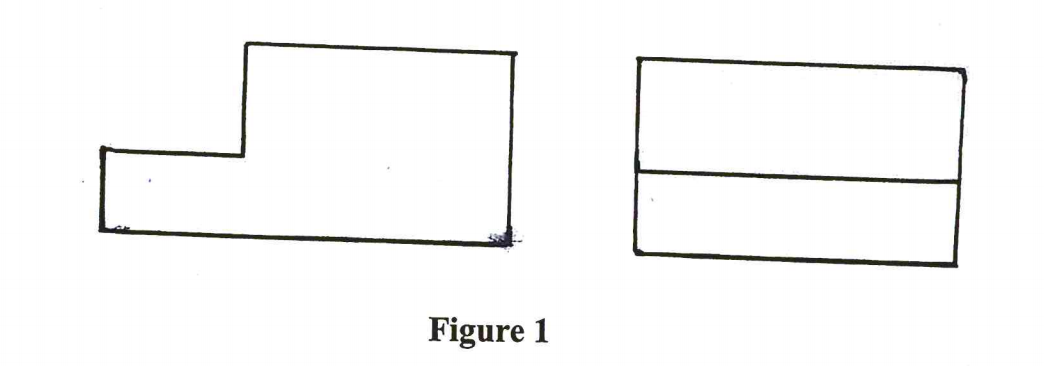
SECTION B (56 marks)
Answer any four questions from this section in the space provided.
11. (a) Name four aircraft systems that use pneumatic power. (2 marks)
(b) With the aid of sketches, describe the following types of landing gear configuration:
(i) Tri-cycle
(ii) Conventional (6 marks)
(c) Explain how steering is achieved in each of the gear configuration in 11(b). (i) Tri-cycle
(ii) Conventional (6 marks)
12. (a) Describe each of the following business ventures in aviation, stating two merits and two demerits for each.
(i) Cargo and courier services
(ii) Aircraft maintenance shop
(b) Outline three effects on the human body due to high altitude flights.
(c) (i) State six functions of the Kenya Civil Aviation Authority (KCAA). (6 marks)
(ii) Identify any two categories of airports in Kenya and explain the kind of inspection carried out in each category. (2 marks)
13. (a) With regards to the six basic flight instruments: (i) show the typical layout
(ii) state the functions of each of the flight instruments (12 marks)
(b) Explain the meaning of each of the following terms as applied to aviation: (i) VFR
(ii) IFR , (2 marks)
14. (a) Sketch each of the following aircraft wing forms:
(i) Anhedral
(ii) Gull wing
(b) With the aid of a sketch, describe the formation of induced drag.
(c) Illustrate each of the following types of flaps:
(i) Single slotted flap
(ii) Split flap (3 marks)
15. Figure 2 shows three orthographic views of an engine mounting bracket. Draw the mounting bracket full size in isometric projection taking X to be the lowest point. (14 marks)
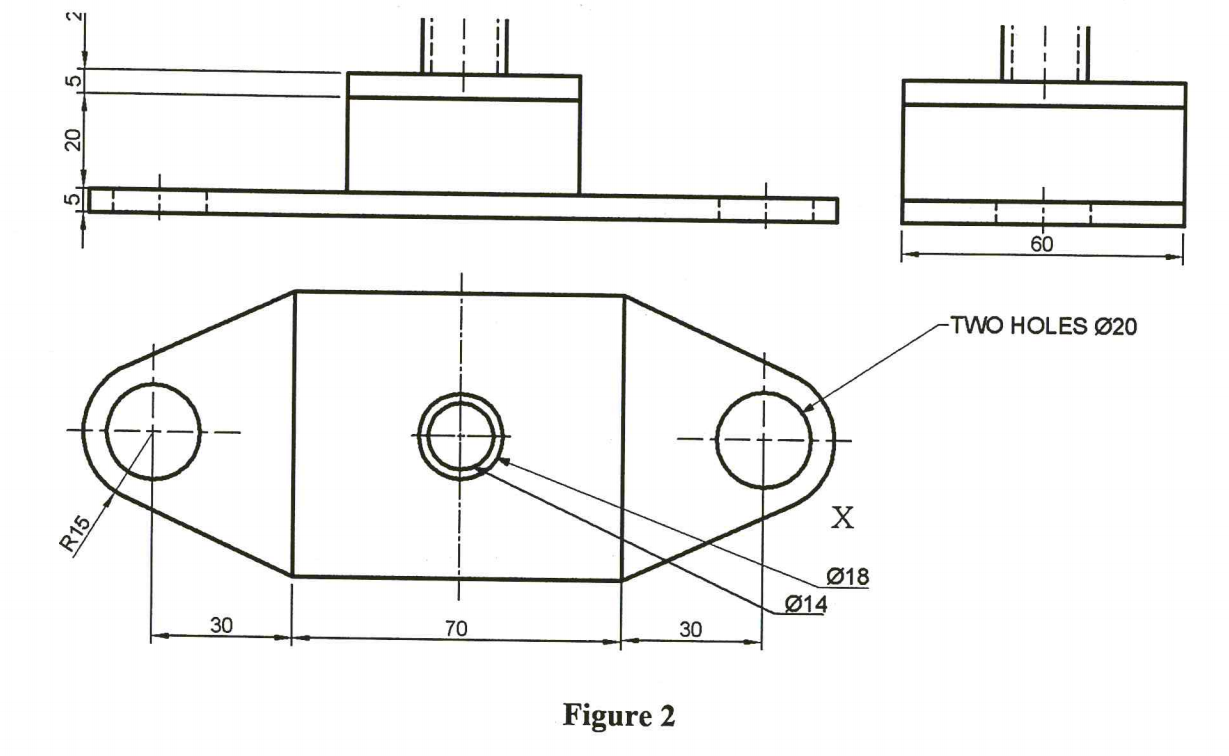
2019 KCSE Aviation Technology Paper 1 Past Paper-Marking Scheme/Answers
1. State two safety precautions to be observed with respect to dressing when operating a grinding machine. (1 mark)Do not wear loose clothing. Always use safety goggles. Wear safety boots.
(b) Give the classes of fire likely to occur in each of the following areas:
(i) Aircraft technical records Class A fire
(ii) Paint store (1 mark)Class B fire
(c) Outline two mandatory safety equipment to be carried by an aircraft flying over water.(1 mark)Life jackets Life rafts Distress signals
2. (a) State four ways of preventing accidents in an aviation environment. (2 marks)Seek assistance if not sure Avoid hasty movements Apply safety regulations Re-training on equipment Do not take wrong orders to operate equipment Exercise caution Love your job
(b) Highlight two roles of a flight dispatcher. (1 mark)Flight planning Release of aircraft
3. (a) Outline three reasons for abnormal moods and poor decision-making in aviation industry. (3 marks)Fatigue Drug abuse Stress
(b) Outline three adverse effects of cumulonimbus clouds on an aircraft in flight.Poor communication due to lighting and thunder. Poor visibility due to heavy rain or clouds. Change of direction or instability due to turbulence. 4. (a) Sketch and label the following aircraft hardware:
(0 Countersunk rivet
(ii) Raised head screw
(b) Outline the procedure of annealing steel.Heat the metal to just above the upper critical point. Cool it very slowly in ash, sand or furnace, i.e. quench slowly.
5. State the use of each of the following tools:
(a) Odd leg callipers To find the center of a circular rod. For transferring measurements. For drawing parallel lines.
(b) Flat screw driver
Tightening or making loose flat head screws with straight slots.
6. (a) Differentiate between propeller driven and pure jet engine methods of thrust generation.(2 marks)
(i) Pure jet engines give a big acceleration to a small mass of air.
(ii) Propeller driven engines give a small acceleration to a big mass.
(iii) Fire wall (fire bulkhead) separate heat areas.
(b) Explain why propeller blades are twisted.(1 mark)Propeller blades are twisted to ensure equal work is done along the whole blade length.
7. (a) Explain the functions of each of the main structural member of the semi-monocoque aircraft-construction.Longerons take up bending loads. Frames give the aircraft its circular shape and provide attachment for longerons and stringers. They give the aircraft its rigidity. Stringers give support, strength and provide attachment to the air- craft skin. Bulkheads provide rigidity and partitioning. The skin provides the aircraft structural cover and takes up aerody- namic loads.
(b) Name four methods of non destructive testing used in aircraft inspection. (2 marks) Visual Ultra sonic Radiographic (x-ray) Magnetic particle Dye penetrant Eddy current
8. (a) State four methods used in aircraft navigation. (2 marks)
(i) Dead reckoning
(ii) Astral
(iii) Visual
(iv) Radio
(v) Global position GPS
(b) With regards to aircraft systems, complete Table 1.(4 marks)
| Part | System | Function |
|---|---|---|
| Pump | Fluid system lubrication pneumatic hydraulic | To create motive force in the fluid system, or lubrication system, etc |
| Transformer | Electrical | Steps up or down the voltage Measures temperature |
| Thermocouple | Instrument Fire detection | Detects increase in temperature |
| Actuator | Pneumatic or hydraulic | Converts fluid pressure into mechanical movement (work) |
9. With the aid of labelled sketches, show the airflow over each of the following body shapes:
(a) Flat plate(2 marks)
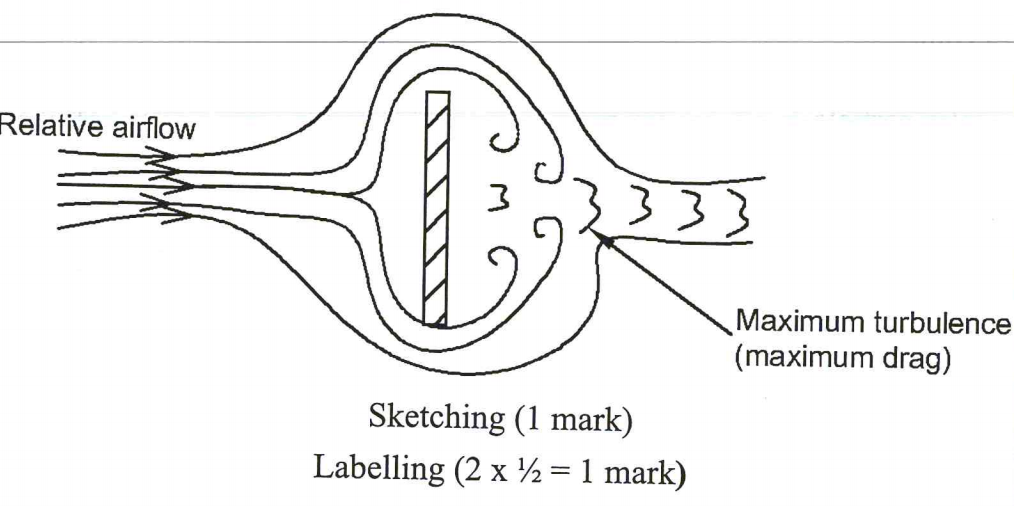
(b) Stationary sphere(2 marks)
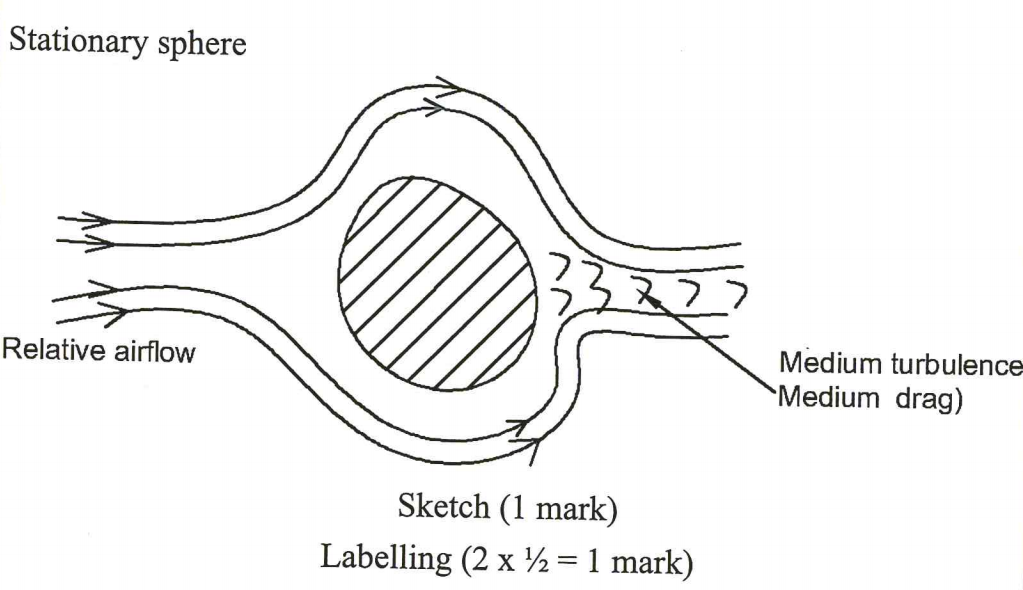
(c) Asymmetrical airflow at 0 angle of attack(2 marks)
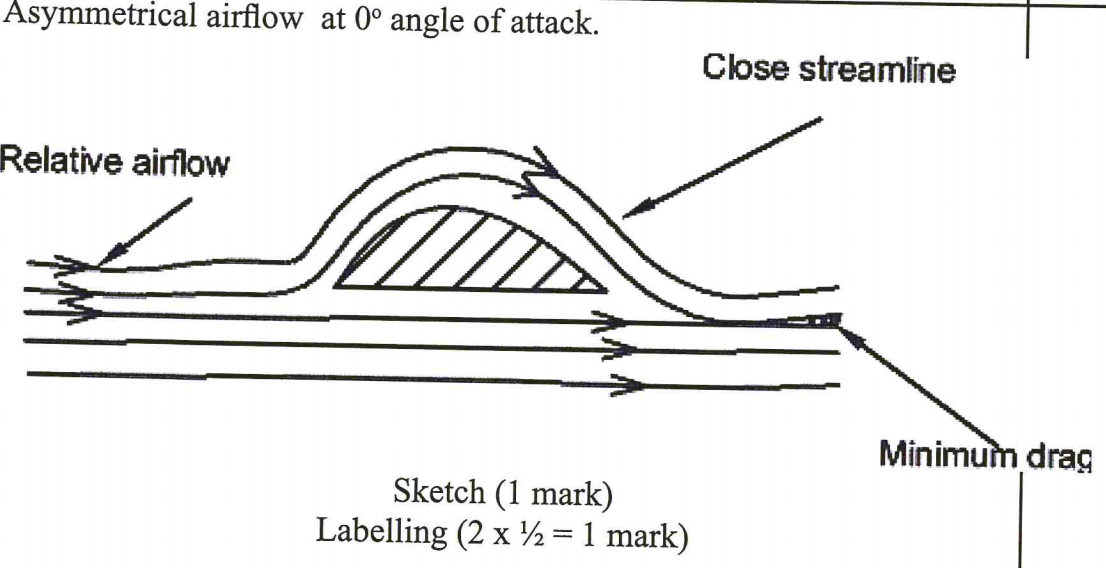
10. (a) Draw the following types of lines used in engineering drawings:
(i) Centre line
___ _ ____ _ ____ _ ____ _ ____ _ _____ _ ___
(ii) Hidden detail line (1 marks)
—————————————
(b) Figure 1 shows two views of an aircraft part drawn in first angle orthographic projection. Draw the plan


SECTION B (56 marks)
Answer any four questions from this section in the space provided.
11. (a) Name four aircraft systems that use pneumatic power. (2 marks) Air conditioning system Pressurization system Aerofoil and engine anti-icing and de-icing system Gas turbine engine starting system Aircraft emergency systems
(b) With the aid of sketches, describe the following types of landing gear configuration:
(i) Tri-cycle
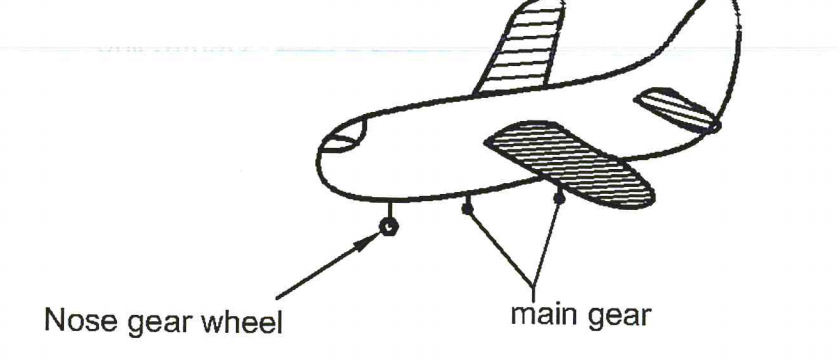
(ii) Conventional (6 marks)
(c) Explain how steering is achieved in each of the gear configuration in 11(b). (i) Tri-cycle
(ii) Conventional (6 marks)
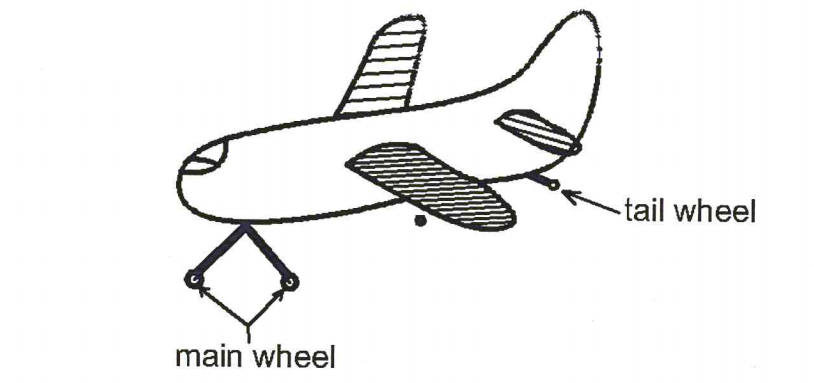
12. (a) Describe each of the following business ventures in aviation, stating two merits and two demerits for each.
(i) Cargo and courier services
This is the business of transporting cargo, letters and money.
(i) Cargo And Courier Services This is the business of transporting cargo, letters and money.
Advantages Aircraft are a fast means of transport. Aircraft transport is reliable.
Disadvantages Some cargo can be hazardous or poisonous which may not be carried on aircraft. This needs a lot of care and safety in handling. Some cargo can be considered a security threat for example explosives.
(ii) Aircraft maintenance shop
For the repairs, servicing and painting of aircraft (ground handling) (1 mark)
Advantages Easy availability of clients Closeness to the market because of many small aircraft operators Provides direct employment to qualified personnel (availability of skilled labour).
Disadvantages Expensive to set up Stiff competition from established operators Expensive spare parts Legislative (licensing) challenges
(b) Outline three effects on the human body due to high altitude flights.
(i) Low temperature which may lead to freezing.
(ii) Low pressure which leads to decrease in oxygen, may cause hypoxia and anoxia.
(iii) Low humidity at high altitudes causes itching, sore throat and dry skin.
(c) (i) State six functions of the Kenya Civil Aviation Authority (KCAA). (6 marks) Licensing of air services. Provision of air navigation services. Ensuring safety and efficiency in Kenyan airspace (air traffic control services) Accident investigation Aircraft registration Enforcing technical standards Examination of technical personnel Advising the government of matters concerning civil aviation
(ii) Identify any two categories of airports in Kenya and explain the kind of inspection carried out in each category. (2 marks)Categories of airports in Kenya. Category A – inspected daily Category B – inspected weekly Category C – no inspection Category D – private
13. (a) With regards to the six basic flight instruments: (i) show the typical layout
(ii) state the functions of each of the flight instruments (12 marks)
(b) Explain the meaning of each of the following terms as applied to aviation: (i) VFR
(ii) IFR (2 marks)
14. (a) Sketch each of the following aircraft wing forms:
(i) Anhedral
(ii) Gull wing
(b) With the aid of a sketch, describe the formation of induced drag.
(c) Illustrate each of the following types of flaps:
(i) Single slotted flap
(ii) Split flap (3 marks)
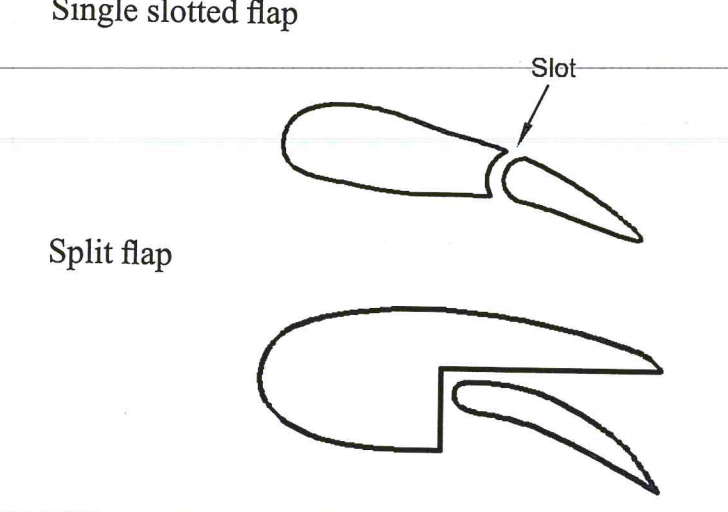
15. Figure 2 shows three orthographic views of an engine mounting bracket. Draw the mounting bracket full size in isometric projection taking X to be the lowest point. (14 marks)



